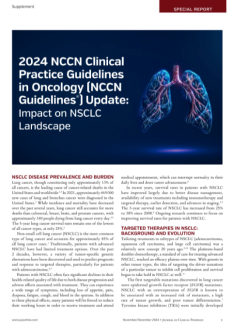Machine Learning Identifies Key Genomic Markers to Predict CPI Outcomes in NSCLC
Researchers have leveraged machine learning (ML) to uncover genetic signatures that can predict responses to checkpoint inhibitors (CPI) in non–small cell lung cancer (NSCLC), offering new insights into resistance mechanisms and potential therapeutic targets. The study utilized a genetic algorithm-based ML framework to analyze data from the deidentified Flatiron Health and Foundation Medicine NSCLC clinico-genomic database (FH-FMI CGDB) to identify genomic markers that predict clinical responses to CPI therapy.
From the study cohort of 7360 patients, 1150 patients with advanced-stage disease treated with monotherapy anti-PD-1 or anti-PD-L1 antibodies were studied. Patients were categorized as either responders or resistant to CPI based on real-world clinical outcome data, including progression-free survival over a 270-day period.
The analysis revealed that different mutations within the same gene can lead to opposing responses to CPI therapy, challenging conventional single-gene analysis approaches. Notably, TP53 mutations alone did not significantly impact survival, but when co-occurring with KRAS and NF1 mutations, they were associated with differential outcomes. Similarly, KEAP1 mutations exhibited opposing effects depending on specific mutation types, further underscoring the complexity of tumor genetic interactions.
Using statistical and network-based analysis, the researchers identified key mutations and pathways linked to CPI response. Mutations in BRAF, BRIP1, ASXL1, and CDKN2B correlated with treatment outcomes, with CDKN2B deletion specifically associated with decreased overall survival (OS) in CPI-treated patients. Furthermore, pathway analysis highlighted the involvement of IFN-α/β, EGFR, IL-6, and WNT/β-catenin, PTEN, and LKB1/STK11-related pathways in modulating CPI responses. Some of these pathways have already been investigated for their roles in immunotherapy resistance, but novel pathways such as PDGF, ESR1, and IGF signaling were also identified as potential contributors to CPI resistance.
The findings suggest that integrating genomic signatures with existing biomarkers, such as PD-L1 and tumor mutational burden, could enhance patient stratification and increase the likelihood of response to CPI therapy. Additionally, the study highlights potential therapeutic strategies, such as targeting IL-6 signaling, which has been linked to poor CPI responses across multiple cancer types.
By providing a comprehensive analysis of tumor-intrinsic genetic determinants of CPI response, this study lays the groundwork for the development of predictive models that could refine patient selection and guide personalized immunotherapy approaches in NSCLC. Future research, including RNA sequencing and functional validation studies, will be needed to further elucidate the mechanisms underlying these genetic associations and to optimize CPI-based treatment strategies.
Reference
Fomin V, So WV, Barbieri RA. Machine learning identifies clinical tumor mutation landscape pathways of resistance to checkpoint inhibitor therapy in NSCLC. J Immunother Cancer. 2025;13(3):e009092. doi:10.1136/jitc-2024-009092

















